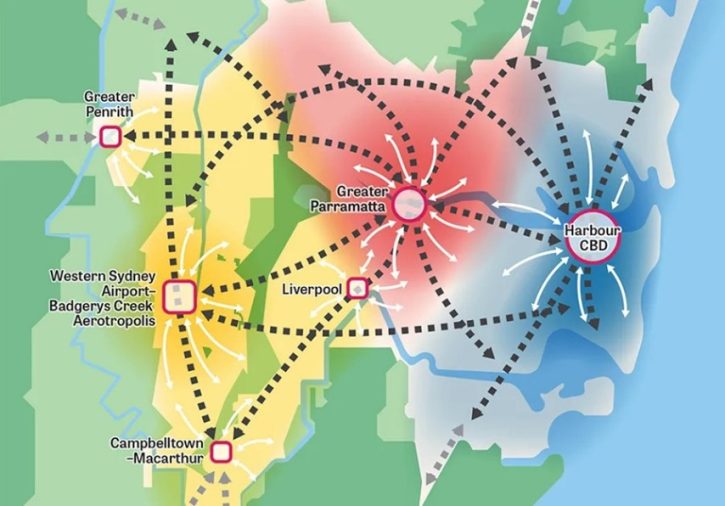Reaching Out to the Metropolitan Growth Corridors in Continuing Neoliberal Times

By Denis Bright
Metropolitan growth plans for inner city and outer suburban residential areas operate in all states and territories. Any planning advances provide charismatic leaders with photo opportunities for news bytes of the latest inspirational solutions to affordability, social and cultural problems.
The change of government in NSW has brought only some tinkering with the Greater Sydney Region Plan 2036. There is some new focus on affordability, sustainability, and community engagement but the Minns Government is quite committed to due processes in planning.
These adjustments have been made through a commitment to co-investment partnerships with the private sector rather than on direct government financial support for the NSW Generations Fund to proceed with the Greater Sydney Plan for 2036 (Image: Greater Cities Commission):

The previous LNP State Government was aware of the political volatility of Western Sydney. Despite the best efforts of the LNP in financing planning initiatives, the state seats of Parramatta, Penrith and Riverstone were all casualties of the 6.3 percent swing to the Minns Government after preferences across NSW on 23 March 2023.
Impression artist, Arthur Stretton (1867-1943), captured the spirit of the land along the upper reaches of the Hawkesbury River between Richmond Bridge and Windsor in 1886 with the escarpment of the Blue Mountains in the background. Recycling all this into shopping malls and unaffordable housing estates would be a national crime (Image: National Gallery of Victoria Showing Impressions of the Purple Noons Transparent Might from 1896):

The previous state LNP Government offered financial support to the NW Growth Area Strategy. The WestInvest Community Fund built-up $5 billion in assets from the NSW Generations Fund. The Generations Fund was topped up by the sale of public equity in the M4 WestConnex Motorway to a leading multinational infrastructure provider. In the dash for cash, the NSW Generations Fund placed public funds on global money markets with mixed success in the difficult recovery phase from COVID-19 as covered by Peter Hannam in The Guardian (21 October 2021).
All this financial support to Western Sydney could not protect residents from the essentially neoliberal character of outer metro development in the post-1996 era with its containment of public sector spending, tax avoidance strategies for multinational investors and of course tax breaks for households investing in the property market. Good intentions in the corridors of power and influence could not correct the essential limitations of neoliberal urban systems.
During less interventionist phases in public policy in the post-1996 era, corporate investment soon took over where resources were removed from the public sector in public housing and community development.
Riverstone Mall was acquired by the Vicinity Centre in 2012 at a cost of $250 million. The Riverstone Mall had been operational since 1984. Finance was provided by superannuation investment and overseas institutional investment companies like the US based Vanguard Group, State Street Corporation as well as BlackRock Investment in both Britain and the USA. These US firms are a feature of the investment profiles of so much outer-metro development across Australia.

Realty 1 Partners-Riverstone Shopping Mall, Sydney West
Nearby houses and town units are in the million-dollar price range. Access to this market requires a deposit of well over $250,000 and a monthly repayment of over $5,500 per month for at least 30 years.
More recently, most states and territories in Australia are tinkering with co-investment strategies to the excesses of neoliberal urbanization in outer metro corridors as noted from media monitoring. Without the vast revenue windfalls from mineral and gas royalties in the more resource rich states, NSW is greatly affected by real term cuts in Commonwealth Grants and GST allocations in a slowing economy. The costs of delivering Stage 3 Tax Cuts and future increases in defence spending on the AUKUS deal will not assist with this structural problem.
Similar commitments in Britain have produced a stagnant economy which has been worsened by Brexit from the days of Boris Johnston, a key architect of the AUKUS deal on the sidelines of the G20 Summit in Cornwall in 2020.
Overseas, Denmark had a history of using smart co-investment strategies to assist with the provision of multiplier investment for infrastructure and community development. Such alternatives work well in prosperous times but even Denmark has been unable to sustain its post-COVID-19 recovery even under an interventionist social democratic government.
Dissenting viewpoints have emerged from progressive economists and urban planners on the post-1996 style of economic development in Australia as revealed by media monitoring from Saul Eslake, John Quiggin and Cameron Murray from the Centre for Housing Research at the University of Tasmania. Urban Planners Calling for Alternatives to Neoliberal Property Markets and Tax Breaks for Investors. Readers can easily research the suggestions from Peter Mares of the University of Melbourne and Emma Saunders of the University of NSW.
Our current trading ties and investment ties with leading Asian economies are the best protection of even a reasonable degree of national sovereignty and greater affordability for the residents of outer metro growth areas which are always under political challenges from far-right populism.
After decades of commitment by LNP national governments in the post-1996 era, the pathways to alternative ways and means of delivering social justice for the outer-metropolitan growth corridors are not well defined. The International Monetary Fund last week warned the federal government that the nation’s infrastructure spending boom has helped push the economy beyond full capacity (AFR 1 November 2023):
The International Monetary Fund has warned the federal government that the nation’s infrastructure spending boom has helped push the economy beyond full capacity, requiring the Reserve Bank to increase interest rates further to tame inflation.
Transport experts and economists backed the IMF’s call to scale back the record $30 billion a year of public infrastructure spending that is competing for scarce labour and materials and nominated Victoria’s $125 billion suburban rail loop as a prime candidate for the chopping block.
However, some of the criticisms through IMF’s Australian Chief Abdoul Wane is probably ideologically motivated by links to US business lobbies and to the US Department of Commerce which closely monitors Australia’s compliance with the Australia-US Free Trade Agreement (AUSFTA) relating to investment protocols. AUSTRADE as a possible compliant partner in the ongoing assessments of our joint commitments to neoliberal values in trade and investment.
Commitment to co-investment to diversify investment in outer metro infrastructure and community development received no mentions in the previous LNP’s State Infrastructure Strategy of 2022-42 which was released in May 2022.
NSW Premier Minns and Minister for Planning and Public Spaces Paul Scully have taken some minor initiatives to improve housing affordability in the Macquarie Park Innovation Precinct (MPIP) adjacent to office market precincts behind Parramatta, North Sydney and Sydney CBD (9 November 2023).
Along with residential development, the revitalisation proposal includes ground level retail for entertainment, dining, and recreation. The new public open space would include play areas, sports fields, fitness stations, BBQ areas along with picnic tables and shelters. The rezoning proposal builds on the vision set out in the Macquarie Park Innovation Precinct (MPIP) Place Strategy finalised by the Department of Planning and Environment (DPE) in 2022 which outlines a staged approach to the development and transformation.
With the Sydney Property Market still well-overpriced, it is probably too late for the NSW Generations Fund to invest in new assets to implement co-investment strategies around transport-oriented locations with a significant social housing component. Strategies like that must await neoliberal market corrections fuelled by interest rate increases. Open-Agent has the grim details for Sydney householders to October 2023:

Ironically, Australia’s growing multinational property sectors with its shopping malls and adjacent housing precincts can ride out market corrections as their capital investment sectors are not directly affected by RBA interest rate decisions. New investment on a future falling market is well served by systematic tax avoidance strategies as covered recently by ABC News (8 November 2023).
Difficult times require more such initiatives to take hard-pressed householders out of the neoliberal era. This should not have to be a fully state responsibility. There is still time to ditch more of the economic and strategic policies from the Morrison era before they bring more hardship to voters in outer metro growth areas where federal Labor’s vote is always highly volatile (Image: The Conversation 25 October 2022):

 Denis Bright (pictured) is a financial member of the Media, Entertainment and Arts Alliance (MEAA). Denis is committed to consensus-building in these difficult times. Your feedback from readers advances the cause of citizens’ journalism. Full names are not required when making comments. However, a valid email must be submitted if you decide to hit the Replies Button.
Denis Bright (pictured) is a financial member of the Media, Entertainment and Arts Alliance (MEAA). Denis is committed to consensus-building in these difficult times. Your feedback from readers advances the cause of citizens’ journalism. Full names are not required when making comments. However, a valid email must be submitted if you decide to hit the Replies Button.
Like what we do at The AIMN?
You’ll like it even more knowing that your donation will help us to keep up the good fight.
Chuck in a few bucks and see just how far it goes!
Your contribution to help with the running costs of this site will be gratefully accepted.
You can donate through PayPal or credit card via the button below, or donate via bank transfer: BSB: 062500; A/c no: 10495969










12 comments
Login here Register here-
New England Cocky -
Leila -
Maisie -
Denis Bright -
Tessa_M -
James Robo -
New England Cocky -
corvusboreus -
Stella -
Phil Pryor -
New England Cocky -
Fran
Return to home pageYour pic labelled ” National Gallery of Victoria Showing Impressions of the Purple Noons Transparent Might from 1896” bears an uncanny resemblance to Gurners ”View of the Bellingen Valley from Marx Hill”.
Co-Investment is indeed to the buzz word as an alternative to the excesses of the alternatives
Keep working on solutions to community problems that are available to both sides of politics.
A good background on the works of Elioth Gurner;’s art work: https://freepages.rootsweb.com/~jray/genealogy/artists/index.htm
Readers can check out the landscapes themselves to follow the Bellinger River from Urunga to Bellingen and Dorrigo with connections onto New England. Bike riders can easily make the 15 km trip from Urunga Station if they are coming from Sydney.
Even the property market has reached the Bellinger Valley transforming localities near the estuary at Repton and Mylestom.
Our urban centres should not be just commercial hubbs. Co-investment can achieve a better balance between the needs of investors and the masses of people who swipe the check-out terminals.
Cities in Northern NSW need massive investment in flood control and infrastructure. Best wishes to our new Minns Government and his team, The term Minns-slide will soon be applied to his re-election after a pleasant first term in government.
@ Denis Bright: Sounds like you support the proposition that ”any reason to go to Bellingen is a good enough reason”.
We looked at re-locating to Bellingen a few years ago and discovered that it was so popular that real estate agents were asking then Sydney real estate prices.
Even so, Bellingen is a great place to live with clean air, open spaces and no paid rolling carparks for hours getting to work (if you have to).
Dear everyone,
Bellingen, although picturesque, is located in a sweltering river basin blocked from any hint of sea breezes by the barrier of Fernmount ridge.
Bellingen floods regularly (cutting the town in twain) and the much of the riverside vegetation consists of Camphor laurel festooned with Madeira & balloon vine.
Demographically, Bellingen has amongst the highest rates of unemployment & hepatitis in NSW.
It does, however, have an excellent leatherworking shop, one of the finest purveyors of smallgoods on the MNC, a vibrant monthly market, and the upper sections of the river (upstream of Thora) have some good sections of standing-wave rapids for the kayak-inclined.
Worth a look (whilst passing through).
Thanks for an interesting and well researched article on infrastructure investment.
The implications and cogitations that might arise from this are so numerous, that one wonders (and wanders) like Streeton (not Stretton) looking for that perfect scene. Bellingen gets an overmention, for no more large scale sensible development could possibly occur as to take off the heat from Sydney expansion. Australia has a low population to area relativity, under four per square k, so putting people somewhere should be easy.., but that is not so. People must have accesses, conveniences, infrastructure, satisfied expectations, modernity as they see it, and health, education, work, housing positions are always a challenge here. A former late relative was headmaster in Bellingen, and as a ham radio enthusiast, was often the only connection to the world in flood, back then. All of the NSW coastal areas are now suspect for more development without reconsiderations and unlimited money, for climate change, flooding, communication, so many areas, are now to be weighed differently. So much of Australia is unsuitable, with revised better foresight, flood or drought, feast or famine…
@ corvusboreus: Aw shucks CB, you omitted the fine coffee found at both the Swiss Patisserie and Hearthfire Bakery, the latter also producing GF bread. Then there is the award winning Gelato Shop up the west end.
.
Obviously passed through too quickly …. your travelling must have been during the summer heat …..
The article appears to be just about Sydney but it is also about the role of US multinationals in major property projects.
Smaller firms which are not in the multinational loop suffer also.